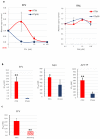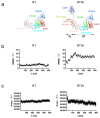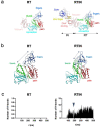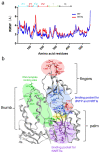Cis-Allosteric Regulation of HIV-1 Reverse Transcriptase by Integrase
- PMID: 36680070
- PMCID: PMC9864105
- DOI: 10.3390/v15010031
Cis-Allosteric Regulation of HIV-1 Reverse Transcriptase by Integrase
Abstract
Reverse transcriptase (RT) and integrase (IN) are encoded tandemly in the pol genes of retroviruses. We reported recently that HIV-1 RT and IN need to be supplied as the pol precursor intermediates, in which RT and IN are in fusion form (RTIN) to exert efficient reverse transcription in the context of HIV-1 replication. The mechanism underlying RTIN's effect, however, remains to be elucidated. In this study, we examined the effect of IN fusion on RT during reverse transcription by an in vitro cell-free assay, using recombinant HIV-1 RTIN (rRTIN). We found that, compared to recombinant RT (rRT), rRTIN generated significantly higher cDNAs under physiological concentrations of dNTPs (less than 10 μM), suggesting increased affinity of RTIN to dNTPs. Importantly, the cleavage of RTIN with HIV-1 protease reduced cDNA levels at a low dose of dNTPs. Similarly, sensitivities against RT inhibitors were significantly altered in RTIN form. Finally, analysis of molecular dynamics simulations of RT and RTIN suggested that IN can influence the structural dynamics of the RT active center and the inhibitor binding pockets in cis. Thus, we demonstrated, for the first time, the cis-allosteric regulatory roles of IN in RT structure and enzymatic activity.
Keywords: HIV-1; deoxyribonucleoside triphosphates; integrase; integration; molecular dynamics; pol; protease; reverse transcriptase.
Conflict of interest statement
The authors declare no conflict of interest.
Figures








Similar articles
-
Critical Contribution of Tyr15 in the HIV-1 Integrase (IN) in Facilitating IN Assembly and Nonenzymatic Function through the IN Precursor Form with Reverse Transcriptase.J Virol. 2016 Dec 16;91(1):e02003-16. doi: 10.1128/JVI.02003-16. Print 2017 Jan 1. J Virol. 2016. PMID: 27795445 Free PMC article.
-
Altered viral fitness and drug susceptibility in HIV-1 carrying mutations that confer resistance to nonnucleoside reverse transcriptase and integrase strand transfer inhibitors.J Virol. 2014 Aug;88(16):9268-76. doi: 10.1128/JVI.00695-14. Epub 2014 Jun 4. J Virol. 2014. PMID: 24899199 Free PMC article.
-
Interaction between Reverse Transcriptase and Integrase Is Required for Reverse Transcription during HIV-1 Replication.J Virol. 2015 Dec;89(23):12058-69. doi: 10.1128/JVI.01471-15. Epub 2015 Sep 23. J Virol. 2015. PMID: 26401032 Free PMC article.
-
Cutting into the Substrate Dominance: Pharmacophore and Structure-Based Approaches toward Inhibiting Human Immunodeficiency Virus Reverse Transcriptase-Associated Ribonuclease H.Acc Chem Res. 2020 Jan 21;53(1):218-230. doi: 10.1021/acs.accounts.9b00450. Epub 2019 Dec 27. Acc Chem Res. 2020. PMID: 31880912 Free PMC article. Review.
-
Dimerization inhibitors of HIV-1 reverse transcriptase, protease and integrase: a single mode of inhibition for the three HIV enzymes?Antiviral Res. 2006 Sep;71(2-3):260-7. doi: 10.1016/j.antiviral.2006.05.021. Epub 2006 Jun 28. Antiviral Res. 2006. PMID: 16872687 Review.
Cited by
-
The genome evolution of Marek's disease viruses in chickens and turkeys in China.Virus Genes. 2023 Dec;59(6):845-851. doi: 10.1007/s11262-023-02034-7. Epub 2023 Oct 18. Virus Genes. 2023. PMID: 37851282
-
From Origin to the Present: Establishment, Mechanism, Evolutions and Biomedical Applications of the CRISPR/Cas-Based Macromolecular System in Brief.Molecules. 2025 Feb 18;30(4):947. doi: 10.3390/molecules30040947. Molecules. 2025. PMID: 40005257 Free PMC article. Review.
-
Loxapine inhibits replication of hepatitis A virus in vitro and in vivo by targeting viral protein 2C.PLoS Pathog. 2024 Mar 13;20(3):e1012091. doi: 10.1371/journal.ppat.1012091. eCollection 2024 Mar. PLoS Pathog. 2024. PMID: 38478584 Free PMC article.
References
-
- Brown P.O. Integration. In: Coffin J.M., Hughes S.H., Varmus H.E., editors. Retroviruses. Cold Spring Harbor Laboratory Press; Long Island, NY, USA: 1997. pp. 161–203. - PubMed
-
- Tsurutani N., Kubo M., Maeda Y., Ohashi T., Yamamoto N., Kannagi M., Masuda T. Identification of Critical Amino Acid Residues in Human Immunodeficiency Virus Type 1 IN Required for Efficient Proviral DNA Formation at Steps prior to Integration in Dividing and Nondividing Cells. J. Virol. 2000;74:4795–4806. doi: 10.1128/jvi.74.10.4795-4806.2000. - DOI - PMC - PubMed
Publication types
MeSH terms
Substances
LinkOut - more resources
Full Text Sources

